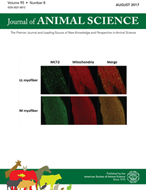-
Views
-
Cite
Cite
C. A. Moran, G. Fusconi, M. Morlacchini, K. A. Jacques, 124 Docosahexaenoic acid content in longissimus dorsi and backfat tissues of grow-finish pigs fed diets containing 0, 0.25 or 0.5% heterotrophically grown algae: Study 2, Journal of Animal Science, Volume 95, Issue suppl_2, March 2017, Pages 58–59, https://doi.org/10.2527/asasmw.2017.124
Close - Share Icon Share
Abstract
Higher DHA content of pork is of interest to consumers and could provide an added value product for producers and retailers. The study evaluated performance and some aspects of carcass characteristics and composition of grow-finish pigs fed diets containing 0, 0.25, or 0.50% unextracted Aurantiochytrium limacinum CCAP 4087/2 algae (FORPLUSTM, Alltech Inc). A total of 144 pigs (72 gilts and 72 barrows) of 24.1 ± 2.6 kg live weight were fed for 117 d (112 d study plus 5 d to slaughter date). Pigs remained on assigned test diets from the final weight measurement at 112 d to slaughter at 117 d. Average daily gain (ADG), efficiency (feed:gain), and feed intake were measured at 112 d on all animals. Each dietary treatment was replicated in 8 pens (4 pens of gilts and 4 pens of barrows) of 6 animals. At trial end carcass characteristics from 72 animals (3 per pen, half barrows, half gilts) were evaluated. Carcasses from half the animals were used owing to logistical and economic practicalities. Animals were selected with live weights near treatment means within gender. Samples for DHA analysis of LD and backfat were obtained from each right carcass at the 13th rib. ADG, feed intake, and feed:gain were unaffected by algae addition (P > 0.05). Algae had no effect on backfat and LD thickness or lean meat content. DHA content (g/100 g of tissue) increased in LD and backfat of both genders (P < 0.05). LD DHA values were 0.0074, 0.0172, and 0.0252 g/100 g tissue for 0, 0.25, and 0.50% dietary algae, respectively. Total omega-3 FA and omega-3:omega-6 ratio were also increased in LD (P < 0.05). In backfat, total omega-3 FA and the omega-3:omega-6 ratio increased with dietary algae (P < 0.001). DHA increased (0.0723, 0.2210, and 0.3017 g/100 g fat tissue for 0, 0.25, and 0.50% diet algae, respectively; P < 0.05). Extent of treatment effects on DHA content of loin and fat varied with gender. DHA in loin tissue of gilts increased at 2.8 and 2.9X that of controls at 0.25 and 0.5% algae, respectively (P < 0.05). In barrows fed 0.25% algae, loin DHA was 2.7X controls P < 0.05). At 0.50% FORPLUSTM algae, DHA in loin tissue of barrows was 4X that of controls. Similar trends were noted in backfat DHA content. It was concluded that DHA content of LD and backfat increased with dietary algae level. This algae source can be useful in producing pork products to meet targeted DHA levels.





